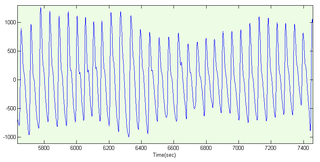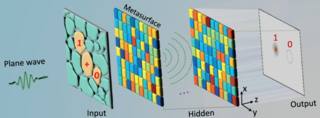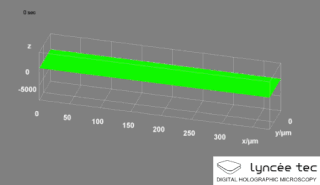Related Research Articles

Microscopy is the technical field of using microscopes to view objects and areas of objects that cannot be seen with the naked eye. There are three well-known branches of microscopy: optical, electron, and scanning probe microscopy, along with the emerging field of X-ray microscopy.

Holography is a technique that enables a wavefront to be recorded and later reconstructed. It is best known as a method of generating three-dimensional images, and has a wide range of other uses, including data storage, microscopy, and interferometry. In principle, it is possible to make a hologram for any type of wave.

Interferometry is a technique which uses the interference of superimposed waves to extract information. Interferometry typically uses electromagnetic waves and is an important investigative technique in the fields of astronomy, fiber optics, engineering metrology, optical metrology, oceanography, seismology, spectroscopy, quantum mechanics, nuclear and particle physics, plasma physics, biomolecular interactions, surface profiling, microfluidics, mechanical stress/strain measurement, velocimetry, optometry, and making holograms.

A spatial light modulator (SLM) is a device that can control the intensity, phase, or polarization of light in a spatially varying manner. A simple example is an overhead projector transparency. Usually when the term SLM is used, it means that the transparency can be controlled by a computer.

The Mach–Zehnder interferometer is a device used to determine the relative phase shift variations between two collimated beams derived by splitting light from a single source. The interferometer has been used, among other things, to measure phase shifts between the two beams caused by a sample or a change in length of one of the paths. The apparatus is named after the physicists Ludwig Mach and Ludwig Zehnder; Zehnder's proposal in an 1891 article was refined by Mach in an 1892 article. Demonstrations of Mach–Zehnder interferometry with particles other than photons had been demonstrated as well in multiple experiments.

A photoplethysmogram (PPG) is an optically obtained plethysmogram that can be used to detect blood volume changes in the microvascular bed of tissue. A PPG is often obtained by using a pulse oximeter which illuminates the skin and measures changes in light absorption. A conventional pulse oximeter monitors the perfusion of blood to the dermis and subcutaneous tissue of the skin.

An optical neural network is a physical implementation of an artificial neural network with optical components. Early optical neural networks used a photorefractive Volume hologram to interconnect arrays of input neurons to arrays of output with synaptic weights in proportion to the multiplexed hologram's strength. Volume holograms were further multiplexed using spectral hole burning to add one dimension of wavelength to space to achieve four dimensional interconnects of two dimensional arrays of neural inputs and outputs. This research led to extensive research on alternative methods using the strength of the optical interconnect for implementing neuronal communications.
Electron holography is holography with electron matter waves. It was invented by Dennis Gabor in 1948 when he tried to improve image resolution in electron microscope. The first attempts to perform holography with electron waves were made by Haine and Mulvey in 1952; they recorded holograms of zinc oxide crystals with 60 keV electrons, demonstrating reconstructions with approximately 1 nm resolution. In 1955, G. Möllenstedt and H. Düker invented an electron biprism, thus enabling the recording of electron holograms in off-axis scheme. There are many different possible configurations for electron holography, with more than 20 documented in 1992 by Cowley. Usually, high spatial and temporal coherence of the electron beam are required to perform holographic measurements.
Holographic interferometry (HI) is a technique which enables the measurements of static and dynamic displacements of objects with optically rough surfaces at optical interferometric precision. These measurements can be applied to stress, strain and vibration analysis, as well as to non-destructive testing and radiation dosimetry. It can also be used to detect optical path length variations in transparent media, which enables, for example, fluid flow to be visualised and analyzed. It can also be used to generate contours representing the form of the surface.
Phased-array optics is the technology of controlling the phase and amplitude of light waves transmitting, reflecting, or captured (received) by a two-dimensional surface using adjustable surface elements. An optical phased array (OPA) is the optical analog of a radio-wave phased array. By dynamically controlling the optical properties of a surface on a microscopic scale, it is possible to steer the direction of light beams, or the view direction of sensors, without any moving parts. Phased-array beam steering is used for optical switching and multiplexing in optoelectronic devices and for aiming laser beams on a macroscopic scale.
Computer-generated holography (CGH) is a technique that uses computer algorithms to generate holograms. It involves generating holographic interference patterns. A computer-generated hologram can be displayed on a dynamic holographic display, or it can be printed onto a mask or film using lithography. When a hologram is printed onto a mask or film, it is then illuminated by a coherent light source to display the holographic images.
Interferometric microscopy or imaging interferometric microscopy is the concept of microscopy which is related to holography, synthetic-aperture imaging, and off-axis-dark-field illumination techniques. Interferometric microscopy allows enhancement of resolution of optical microscopy due to interferometric (holographic) registration of several partial images and the numerical combining.

Digital holographic microscopy (DHM) is digital holography applied to microscopy. Digital holographic microscopy distinguishes itself from other microscopy methods by not recording the projected image of the object. Instead, the light wave front information originating from the object is digitally recorded as a hologram, from which a computer calculates the object image by using a numerical reconstruction algorithm. The image forming lens in traditional microscopy is thus replaced by a computer algorithm. Other closely related microscopy methods to digital holographic microscopy are interferometric microscopy, optical coherence tomography and diffraction phase microscopy. Common to all methods is the use of a reference wave front to obtain amplitude (intensity) and phase information. The information is recorded on a digital image sensor or by a photodetector from which an image of the object is created (reconstructed) by a computer. In traditional microscopy, which do not use a reference wave front, only intensity information is recorded and essential information about the object is lost.
A common-path interferometer is a class of interferometers in which the reference beam and sample beams travel along the same path. Examples include the Sagnac interferometer, Zernike phase-contrast interferometer, and the point diffraction interferometer. A common-path interferometer is generally more robust to environmental vibrations than a "double-path interferometer" such as the Michelson interferometer or the Mach–Zehnder interferometer. Although travelling along the same path, the reference and sample beams may travel along opposite directions, or they may travel along the same direction but with the same or different polarization.

Laser Doppler imaging (LDI) is an imaging method that uses a laser beam to scan live tissue. When the laser light reaches the tissue, the moving blood cells generate doppler components in the reflected (backscattered) light. The light that comes back is detected using a photodiode that converts it into an electrical signal. Then the signal is processed to calculate a signal that is proportional to the tissue perfusion in the scanned area. When the process is completed, the signal is processed to generate an image that shows the perfusion on a screen.
Holographic interference microscopy (HIM) is holographic interferometry applied for microscopy for visualization of phase micro-objects. Phase micro-objects are invisible because they do not change intensity of light, they insert only invisible phase shifts. The holographic interference microscopy distinguishes itself from other microscopy methods by using a hologram and the interference for converting invisible phase shifts into intensity changes.

Quantitative phase contrast microscopy or quantitative phase imaging are the collective names for a group of microscopy methods that quantify the phase shift that occurs when light waves pass through a more optically dense object.

Fourier ptychography is a computational imaging technique based on optical microscopy that consists in the synthesis of a wider numerical aperture from a set of full-field images acquired at various coherent illumination angles, resulting in increased resolution compared to a conventional microscope.
Single-shot multi-contrast x-ray imaging is an efficient and a robust x-ray imaging technique which is used to obtain three different and complementary types of information, i.e. absorption, scattering, and phase contrast from a single exposure of x-rays on a detector subsequently utilizing Fourier analysis/technique. Absorption is mainly due to the attenuation and Compton scattering from the object, while phase contrast corresponds to phase shift of x-rays.

Joseph Rosen is the Benjamin H. Swig Professor in Optoelectronics at the School of Electrical & Computer Engineering of Ben-Gurion University of the Negev, Israel.
References
- ↑ Goodman, Joseph W.; Lawrence, R. W. (1967). "Digital image formation from electronically detected holograms". Applied Physics Letters. 11 (3): 77–79. Bibcode:1967ApPhL..11...77G. doi:10.1063/1.1755043.
- ↑ Macovski, Albert (1969). "Efficient holography using temporal modulation". Applied Physics Letters. 14 (5): 166–168. Bibcode:1969ApPhL..14..166M. doi:10.1063/1.1652759.
- ↑ U. Schnars, W. Jüptner (2005). Digital Holography. Springer. ISBN 9783642060182.
- ↑ Leith, E. N.; Upatnieks, J. (1962). "Reconstructed wavefronts and communication theory". JOSA. 52 (10): 1123–1128. Bibcode:1962JOSA...52.1123L. doi:10.1364/josa.52.001123.
- ↑ Gross, Michel, and Michael Atlan. "Digital holography with ultimate sensitivity." Optics letters 32, no. 8 (2007): 909-911.
- ↑ Yamaguchi, I.; Zhang, T. (1997). "Phase-shifting digital holography". Opt. Lett. 22 (16): 1268–1270. Bibcode:1997OptL...22.1268Y. doi:10.1364/ol.22.001268. PMID 18185816.
- ↑ Atlan, M.; Gross, M.; Forget, B.; Vitalis, T.; Rancillac, A.; Dunn, A. (2006). "Frequency-domain wide-field laser Doppler in vivo imaging". Opt. Lett. 31 (18): 2762–2764. Bibcode:2006OptL...31.2762A. doi:10.1364/ol.31.002762. PMID 16936884.
- ↑ Paturzo, M.; Memmolo, P.; Tulino, A.; Finizio, A.; Ferraro, P. (2009). "Investigation of angular multiplexing and de- multiplexing of digital holograms recorded in microscope configuration". Opt. Express. 17 (11): 8709–8718. Bibcode:2009OExpr..17.8709P. doi: 10.1364/oe.17.008709 . PMID 19466119.
- ↑ J. Kühn; T. Colomb; F. Montfort; F. Charrière; Y. Emery; E. Cuche; P. Marquet; C. Depeursinge (2007). "Real-time dual-wavelength digital holographic microscopy with a single hologram acquisition". Optics Express . 15 (12): 7231–724. Bibcode:2007OExpr..15.7231K. doi: 10.1364/OE.15.007231 . PMID 19547044.
- ↑ Tomohiro Kiire, Daisuke Barada, Jun ichiro Sugisaka, Yoshio Hayasaki, and Toyohiko Yatagai. "Color digital holography using a single monochromatic imaging sensor. Opt. Lett. 37(15):3153–3155, Aug 2012.
- ↑ Tahara, Tatsuki; Maeda, Akifumi; Awatsuji, Yasuhiro; Kakue, Takashi; Xia, Peng; Nishio, Kenzo; Ura, Shogo; Kubota, Toshihiro; Matoba, Osamu (2012). "Single-shot dual- illumination phase unwrapping using a single wavelength". Opt. Lett. 37 (19): 4002–4004. Bibcode:2012OptL...37.4002T. doi:10.1364/ol.37.004002. PMID 23027259.
- ↑ T. Colomb; F. Dürr; E. Cuche; P. Marquet; H. Limberger; R.-P. Salathé; C. Depeursinge (2005). "Polarization microscopy by use of digital holography: application to optical fiber birefringence measurements". Applied Optics . 44 (21): 4461–4469. Bibcode:2005ApOpt..44.4461C. doi:10.1364/AO.44.004461. PMID 16047894.
- ↑ N. Verrier; M. Atlan (2013). "Absolute measurement of small-amplitude vibrations by time-averaged heterodyne holography with a dual local oscillator". Optics Letters. 38 (5): 739–41. arXiv: 1211.5328 . Bibcode:2013OptL...38..739V. doi:10.1364/OL.38.000739. PMID 23455283.
- ↑ Bruno, F.; Laudereau, J. B.; Lesaffre, M.; Verrier; Atlan, M. (2014). "Phase-sensitive narrowband heterodyne holography". Applied Optics. 53 (7): 1252–1257. arXiv: 1301.7532 . Bibcode:2014ApOpt..53.1252B. doi:10.1364/AO.53.001252. PMID 24663351.
- ↑ M. Paturzo; P. Memmolo; L. Miccio; A. Finizio; P. Ferraro; A. Tulino; B. Javidi (2008). "Numerical multiplexing and demultiplexing of digital holographic information for remote reconstruction in amplitude and phase". Optics Letters. 33 (22): 2629–2631. Bibcode:2008OptL...33.2629P. doi:10.1364/OL.33.002629. PMID 19015690.
- ↑ Paturzo, M.; Merola, F.; Grilli, S.; Nicola, S. De; Finizio, A.; Ferraro, P. (2008). "Super-resolution in digital holography by a two-dimensional dynamic phase grating". Optics Express. 16 (21): 17107–17118. Bibcode:2008OExpr..1617107P. doi: 10.1364/OE.16.017107 . PMID 18852822.
- ↑ Verrier, N.; Fournier, C.; Cazier, A.; Fournel, T. (2016). "Co-design of an in-line holographic microscope with enhanced axial resolution: selective filtering digital holography". J. Opt. Soc. Am. A. 33 (1): 107–116. arXiv: 1601.02940 . Bibcode:2016JOSAA..33..107V. doi:10.1364/JOSAA.33.000107. PMID 26831591.
- ↑ P.W.M. Tsang; K. Cheung; T. Kim; Y. Kim; T. Poon (2011). "Fast reconstruction of sectional images in digital holography". Optics Letters . 36 (14): 2650–2652. Bibcode:2011OptL...36.2650T. doi:10.1364/OL.36.002650. PMID 21765497.
- ↑ E. Lam; X. Zhang; H. Vo; T.-C. Poon; G. Indebetouw (2009). "Three-dimensional microscopy and sectional image reconstruction using optical scanning holography". Applied Optics . 48 (34): H113–H119. Bibcode:2009ApOpt..48..113L. doi:10.1364/AO.48.00H113. hdl: 10919/46969 . PMID 19956281.
- ↑ X. Zhang; E. Lam; T.-C. Poon (2008). "Reconstruction of sectional images in holography using inverse imaging". Optics Express . 16 (22): 17215–17226. Bibcode:2008OExpr..1617215Z. doi:10.1364/OE.16.017215. hdl: 10919/46959 . PMID 18958002.
- ↑ Ferraro, P.; Grilli, S.; Alfieri, D.; Nicola, S. De; Finizio, A.; Pierattini, G.; Javidi, B.; Coppola, G.; Striano, V. (2005). "Extended focused image in microscopy by digital holography". Optics Express. 13 (18): 6738–6749. Bibcode:2005OExpr..13.6738F. doi: 10.1364/OPEX.13.006738 . PMID 19498690.
- ↑ Y.Kuznetsova; A.Neumann, S.R.Brueck (2007). "Imaging interferometric microscopy–approaching the linear systems limits of optical resolution". Optics Express . 15 (11): 6651–6663. Bibcode:2007OExpr..15.6651K. doi: 10.1364/OE.15.006651 . PMID 19546975.
- ↑ C.J.Schwarz; Y.Kuznetsova and S.R.J.Brueck (2003). "Imaging interferometric microscopy". Optics Letters . 28 (16): 1424–1426. Bibcode:2003OptL...28.1424S. doi:10.1364/OL.28.001424. PMID 12943079. S2CID 31379.
- ↑ M. Paturzo; F. Merola; S. Grilli; S. De Nicola; A. Finizio; P. Ferraro (2008). "Super-resolution in digital holography by a two-dimensional dynamic phase grating". Optics Express. 16 (21): 17107–17118. Bibcode:2008OExpr..1617107P. doi: 10.1364/OE.16.017107 . PMID 18852822.